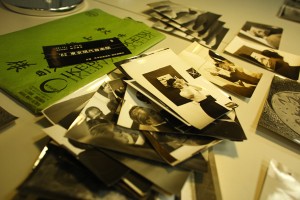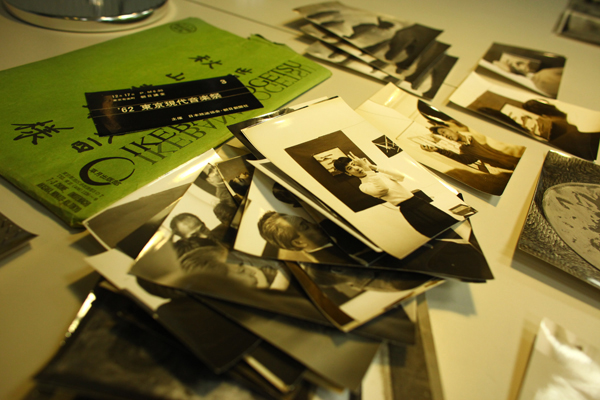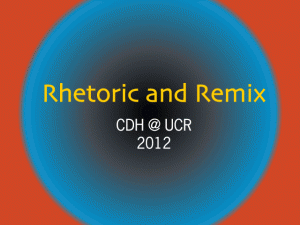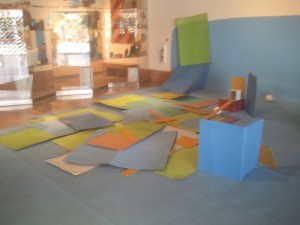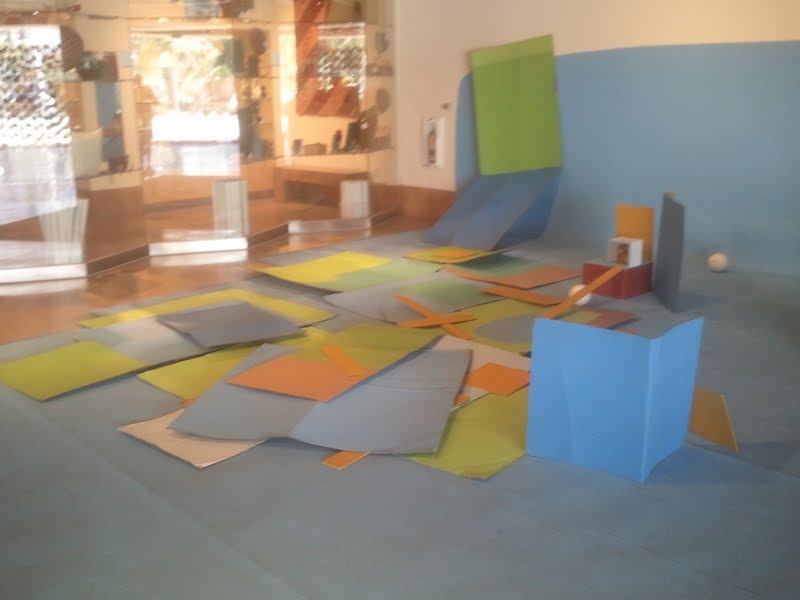Posts from the ‘news’ Category
The Museum of Modern Art launches post, a participatory digital platform for global research
February 20th, 2013
April Durham
The Museum of Modern Art launches post,
a participatory digital platform for global research
post is an open forum for sharing research and circulating works in progress, offering a platform for critical response and an instrument for increasing expertise through exposure to ideas from around the globe. It is a place for conversation and debate, for building a nuanced understanding of the histories that shape our present. As a Web platform, post provides an alternative to the model of a unified art-historical narrative. post instead allows a malleable, layered understanding of multiple notions of modernity to emerge over time, as more people from more places participate.
Emerging out of research undertaken at MoMA, post develops a network of partners and users whose complementary research and concerns will shape future approaches and content. Starting with a specific thematic focus, the site regularly releases essays, interviews, reports, reflections, archival materials, and artists’ commissions, ensuring that new voices are constantly entering the discussion. The site is designed to encourage active participation; users and institutional partners are encouraged to upload their own findings and share their questions, together gaining broader exposure and expertise. In time, and depending upon the interest of the partners, post will broaden its focus.
Committed to investigating artistic practices that have historically been overlooked in MoMA’s collection and exhibitions, post initially explores sites of experimental practices in regions that are the focus of C-MAP research: East Asia, Central and Eastern Europe, and Latin America and the Caribbean. Upon its launch, post will present its first case study, in partnership with Keio University Art Center, featuring the archival materials of Sogetsu Art Center, an epicenter of avant-garde artistic experiments in Tokyo in the 1960s that hosted an exciting, rapid-fire series of programs in experimental music, jazz, and cinema. The initial presentation features essays, interviews, and works by artists related to Sogetsu Art Center—Shiomi Mieko, Yokoo Tadanori, Matsumoto Toshio, andYamaguchi Katsuhiro—and artists who have been the subject of C-MAP research—Geta Brătescu, Chim↑Pom, and Jikken Kobo, among others.
About C-MAP
C-MAP research questions the judgments that grow out of the assumption that artistic modernism is or was determined solely by Western European and North American narratives of early-20th-century avant-gardes. The aim of C-MAP is to understand more fully the historical imperatives and changing conditions of transnational networks of artistic practice, and to seek verbal and material accounts of histories that are little known outside their countries of origin. C-MAP forges new relationships and partnerships and undertakes collaborative research in order to develop new expertise, share what has been learned, and, ultimately, inform the development of exhibitions, publications, educational programs, and MoMA’s collection for the benefit of scholars, curators, educators, students, critics, artists, and the general public.
The Museum of Modern Art’s Contemporary and Modern Art Perspectives in a Global Age Initiative (C-MAP) is supported by The Andrew W. Mellon Foundation and The International Council of The Museum of Modern Art.
Additional funding is provided by Patricia Phelps de Cisneros, Adriana Cisneros de Griffin, and Marlene Hess.
post was designed and developed by TC Labs. Creative direction by Caleb Waldorf.
Post-Graduate Program in New Zealand: Geographies of Media Convergence
January 27th, 2013
April Durham
The School of English and Media Studies is currently seeking applicants for postgraduate scholarships at Massey University Wellington (New Zealand) for a research project that is externally funded by the Marsden Fund of the New Zealand Royal Society and entitled, “Geographies of Media Convergence: Spaces of Democracy, Connectivity and the Reconfiguration of Cultural Citizenship.”
There are scholarships available at both Masters (one year fulltime) and PhD (three years fulltime) levels. We welcome applicants who wish to develop their research interests within our overall project theme. We welcome applications from indigenous scholars and Latin American(ist) scholars and scholars working at the intersection of human geography and media studies.
Master’s Scholarship
This scholarship is for a 1-year fulltime Master’s degree (MA or MPhil) by thesis (i.e., no coursework is involved). It will be awarded to an applicant with a high GPA and a Bachelor’s degree in Media Studies, Cultural Studies, Geography, or a cognate discipline. It covers living costs as well as the full domestic component of tuition fees. The total value of the scholarship is NZD $16,000 plus up to $6,000 in fees. It is open to New Zealand domestic and international students (though international students would be required to provide their own source of funding to make up the shortfall between the domestic and international tuition fees).
PhD Scholarship
This scholarship is for a fulltime 3-year PhD degree (which in New Zealand is a degree by research that does not include a coursework component). It will be awarded to an applicant with a high GPA and a Master’s degree in Media Studies, Cultural Studies, Geography, or a cognate discipline. It covers living costs as well as full domestic tuition fees. It is open to New Zealand domestic as well as international students. The total value of the scholarship is NZD75,000 (NZD25,000 pa) plus fees of up to $6,000 per annum for three years.
Project Summary
We are currently living through a period in which centralized forms of media, such as national television and mainstream journalism, are perceived to be in crisis. This crisis is creating new spaces for the development of alternative ways of knowing, watching and making media. Along with them, media convergence has emerged as a multidimensional concept that references expanding interconnections and interactivity between media technologies, sites, users and production processes, as well as increasingly interactive relationships between politics and popular media cultures. Technological development, media convergence, and attendant transformations of everyday media production, circulation and consumption practices are giving rise to new forms of political discourse and involvement. The proposed research seeks to delineate the possibilities and limitations for contemporary social transformation within this new media ecology. We will do this by exploring a series of media forms, discourses, practices and technologies (including indigenous people’s media as well as contemporary developments in entertainment television) whereby new kinds of cultural citizenship are being actively forged.
This project is thus designed to advance incipient dialogues between human geography and media studies by asking how practices within popular cultures of media convergence can contribute to the construction or renovation of democratic citizenship. The researchers involved with this project will analyze processes of media convergence whereby diverse groups in different parts of the world are actively fashioning new forms of political engagement, identity production and cultural citizenship. The research team will thus explore significant sites of media activity for the production of new political imaginaries within the current global historical conjuncture, which is characterized by four key interrelated elements: 1) the appearance and expansion throughout the world of resurgent and increasingly networked indigenous social movements; 2) the emergence of a highly elaborated and complex convergent media ecology marked by rapid technological development, digitalization, miniaturization and mobilization; 3) the rise and spread of neoliberalism, which is increasingly subject to growing contestation, particularly within Latin America; and 4) increased securitization and militarization organized at multiple levels of social life particularly since September 11, 2001. Within this broad historical conjuncture, areas of focus within our project include 1) the expansion of indigenous television in different parts of the world; and 2) the ongoing transformation of entertainment TV and concomitant proliferation of new modes of interactive engagement with such media by digitally empowered citizens. We propose to examine the processes of convergence culture at work within these phenomena in order to identify and analyze citizenship and citizen-like practices that are occurring across different media formats and platforms.
Application Details
• The closing date for applications is Tuesday, 22 February, 2013
• The preferred starting date for the scholarship is 1 April 2013 (though this is negotiable)
• All applications must be submitted in paper form to and must be postmarked no later than the application closing date. To expedite the review of applications, we encourage you to also submit an electronic version of your application to this email address: j.a.mckenzie@massey.ac.nz
• Your application should include the following:
1. A brief cover letter that contains contact details and your preferred starting date
2. A 1000-word proposal outlining your proposed thesis research and how it fits with the aims of the project
3. Your CV
4. A sample of your academic writing (e.g., for PhD applicants, a published article from an academic journal, Masters thesis chapter, seminar paper, etc.; for Masters applicants, a paper from an upper division undergraduate or Honours-level course).
• Two letters of recommendation from persons competent to speak about your academic record at University level must be sent separately to the project supervisors via the email addresses below.
Further information and instructions on how to apply can be found at:
http://www.massey.ac.nz/?
Informal enquiries about the scholarships prior to the deadline can also be directed to the project supervisors: julie.cupples@ed.ac.uk and K.T.Glynn@massey.ac.nz
Debates in the Digital Humanities is now available online as an open source, and free, project of CUNY:
For those attending the CDH Rhetoric and Remix Reading Group on January 16th, the three articles from Debates in the Digital Humanities are available at the links below:
Lisa Sipro, “This is Why We Fight: Defining the Values of the Digital Humanities”
Alan Liu, “Where is the Cultural Criticism in the Digital Humanities”
I made some changes to the website recently, and most of the changes are based on the new features of the WordPress Jetpack plugin.
1. I removed the Disqus commenting system.
– Disqus has been moving toward becoming a social network of its own, and there was just too much complexity being added to the commenting procedure.
– Comments are now handled solely within WordPress with the Jetpack plugin, and commenters can sign-in to make a comment with their Twitter, Facebook, or WordPress credentials.
– All of the old comments are still there too.
2. The Photon feature of the Jetpack plugin is now active.
– Using the Photon feature allows for integration of our WordPress.org installation with WordPress.com’s CDN (Content Delivery Network).
– This means that images and other information will load faster across the web.
3. We’re now using the Publicize feature of the Jetpack plugin for auto-posting to social networks.
– Previously we were using the “WP to Twitter” plugin which had some hiccups, but only because of Twitter changing their API. Hopefully there will be fewer missteps with the Jetpack plugin.
– Also, we were using Hootsuite to post to Facebook, but I didn’t like this setup. Hootsuite is okay for managing multiple social networking accounts (for a fee), but rather than using a direct-post to Facebook, Hootsuite relies on RSS. There would often be a delay of hours for the WordPress RSS to be read by Hootsuite, and then hopefully Hootsuite would send that info to Facebook. With the Jetpack Publicize feature, things are working much more quickly, and reliably.
– Sadly, Google+ still doesn’t have a public API available for auto-posting.
4. Backups of the site have been made – both a full FTP download, as well as an export of the site’s posts and info.
5. Lastly, I changed the social networking or sharing buttons so they show at the bottom of posts, but they do not show on the front page.
If anyone would like other changes or tweaks, please let me know.
This event has been rescheduled – please see this post for details:
http://cdh.ucr.edu/2013/01/06/rhetoric-and-remix-reading-group-rescheduled/
The Critical Digital Humanities group at UCR announces a reading group:
“Rhetoric & Critical Digital Humanities Scholarship: Rethinking Interactions with Digital Scholarship in terms of Agency, Rhetorical Address, and Reception”
The readings include three short articles from the recent collection Debates in the Digital Humanities and Bernard Stiegler’s book, For a New Critique of Political Economy. Participants should obtain the Stiegler book as we will be discussing it in its entirety.
This reading group will lay the foundation for an ongoing discussion about this year’s theme addressing the rhetoric of digital humanities scholarship.
WHEN: rescheduled for January 16th, 1-2:30pm
WHERE: English Department Conference Room . HMNSS 2212
lunch will be served!
This event is sponsored by the Center for Ideas and Society through a generous grant from the Andrew W. Mellon Workshops in the Humanities.
Rhetoric and Critical Digital Humanities Scholarship: Re-thinking Interactions with Digital Scholarship in terms of Agency, Rhetorical Address, and Reception
What are the rhetorical assumptions made by “digital media scholarship” or the “digital humanities” in both the design and delivery of digital research? How are distinct rhetorical modes or histories entangled in, or excluded from, the interface and interaction designs developed for digital research projects and their presentation?
This year the Critical Digital Humanities research group begins with this fundamental question and our projects will work toward a consideration of the various impacts and affects of digital media.
For the 2012 – 2013 academic year, CDH will focus on what digital media’s particular language or discourse does, and how that language acts in relation to questions of agency. We will explore the rhetoric surrounding the digital humanities and the deployment of that rhetoric in the affective and commonplace experiences that drive digital media practices. CDH events will examine the primary tropes employed in digital media rhetoric as well as their subtexts, and how these factors allow us to think through digital media as an embodied practice.
One of the most common tropes of digital media is its claim of power – the power to democratize the social sphere, resulting in the increased agency of the user. However, in many ways, the construction and circulation of agency in digital media seems to serve the drives of neoliberalism rather than the individual.
Remix practices, interactivity, and social media all present opportunities for resistance to the challenges of neoliberal ideology, and the Critical Digital Humanities research collective will rethink notions of agency through practices of becoming and emergence within digital media.
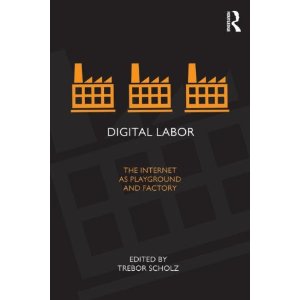 Digital Labor: The Internet as Playground and Factory
Digital Labor: The Internet as Playground and Factory
Edited by Trebor Scholz
Digital Labor asks whether life on the internet is mostly work, or play. We tweet, we tag photos, we link, we review books, we comment on blogs, we remix media, and we upload video to create much of the content that makes up the web. And large corporations profit on our online activity by tracking our interests, affiliations, and habits—and then collecting and selling the data. What is the nature of this interactive ‘labor’ and the new forms of digital sociality that it brings into being? The international, interdisciplinary contributors to Digital Labor suggest that there is no longer a clear divide between ‘the personal’ and ‘work,’ as every aspect of life drives the digital economy: sexual desire, boredom, friendship—and all become fodder for speculative profit. They argue that we are living in a total labor society and the way in which we are commoditized, racialized, and engendered is profoundly and disturbingly normalized by the dominant discourse of digital culture. Digital Labor poses a series of questions about our digital present: How is the global crisis of capitalism linked to the hidden labor of the digital economy? How do we address that most online interaction, whether work or play, for profit or not, is taking place on corporate platforms? How can we acknowledge moments of exploitation while not eradicating optimism, inspiration, and the many instances of individual financial and political empowerment? In response to these questions, this collection offers new definitions of digital labor that address and challenge the complex, hybrid realities of the digital economy.
Introduction: Trebor Scholz Why Does Digital Labor Matter Now? I. The Shifting Sites of Labor Markets
1. Andrew Ross On the Digital Labor Question
2. Tiziana Terranova Free Labor
3. Sean Cubitt The Political Economy of Cosmopolis
4. McKenzie Wark Considerations on A Hacker Manifesto II. Interrogating Modes of Digital Labor
5. Ayhan Aytes Return of The Crowds: Mechanical Turk and Neoliberal States of Exception
6. Abigail De Kosnik Fandom as Free Labor
7. Patricia Clough The Digital, Labor and Measure Beyond Biopolitics
8. Jodi Dean Whatever Blogging III. The Violence of Participation
9. Mark Andrejevic Estranged Free Labor
10. Jonathan Beller Digitality and The Media of Dispossession
11. Lisa Nakamura Don’t Hate the Player, Hate the Game: The Racialization of Labor in World of Warcraft IV. Organizing Networks in an Age of Vulnerable Publics
12. Michel Bauwens Thesis on Digital Labor in an Emerging P2P Economy
13. Christian Fuchs Class and Exploitation on the Internet
14. Ned Rossitter and Soenke Zehle Acts of Translation: Organizing Networks as Algorithmic Technologies of the Common
Sound Art and the Transborder Digital Memorial: Luz María Sánchez’ “2487” at the Riverside Art Museum
September 19th, 2012
Carolyn Schutten
 In conjunction with the Riverside Art Museum’s exhibition You Are Breathing in It: Alternative Art Practices (YABII), Luz María Sánchez’ 2487, a stereo installation from an 8-channel sound piece, is currently on exhibit in the RAM Alcove Hallway. The sound art installation was curated by Carolyn Schutten, a PhD student in public history from UCR, who took part in the Riverside Art Museum Student Curatorial Council (RAMSCC) pilot program.
In conjunction with the Riverside Art Museum’s exhibition You Are Breathing in It: Alternative Art Practices (YABII), Luz María Sánchez’ 2487, a stereo installation from an 8-channel sound piece, is currently on exhibit in the RAM Alcove Hallway. The sound art installation was curated by Carolyn Schutten, a PhD student in public history from UCR, who took part in the Riverside Art Museum Student Curatorial Council (RAMSCC) pilot program.
2487 speaks the names of the two thousand four hundred eighty seven people who died crossing the U.S./Mexico border . The work employs digital technology and sound as a means for transborder memorialization and protest, imposing the absence of those lost into the public sphere. Sánchez’ immersive sound environment remaps social history as the names of the deceased fly across the border through soundscape and digital media. Drawing from data acquired from activist websites, Sánchez created a sound map of names which she recorded digitally. Her final score, along with the database, has been exhibited widely but lives permanently on the world wide web, in commemoration and quiet protest. Sánchez’ work connects the digital and geographic landscape to the listener’s body, gaining entry through sound and transcending political and physical barriers.
Curator Carolyn Schutten will speak about 2487 and the curatorial process, along with the other RAMSCC students, during a panel discussion on September 21 at 6:00 pm. To RSVP please call 951-684-7111 or e-mail Exhibit Liaison Kathryn Poindexter at: ramexhibitions@riversideartmuseum.org.
2487 will be on exhibit from August 9 – September 26, 2012 in the Riverside Art Museum Alcove Hall. YABII will close on September 22, 2012.
For more information on Sánchez sound project, visit: www.diaspora2487.org
Luz María Sánchez’ 2487 was originally commissioned by Artpace San Antonio as part of the International Artist-in-Residence program New Works: 06.2, curated by Yuko Hasegawa, Chief Curator, Museum of Contemporary Art, Tokyo, Japan.
April Durham . 17 August 2012
Long Beach is about 20 minutes southwest of the crumbly LA neighborhood where I am spending a sticky-baked summer. I am too tired to drive and Pam prefers to pilot anyway. It’s already needle hot when we leave at 10:23 am. The 110 to the 5 to the 60 to the 710. Aquarium exit to Broadway to Alamitos. The parking lot is mostly empty and (finally) a sea breeze teases us toward the door. The space is so professional, so institutionally proper, with excellent air conditioning, gleaming floors, and very quietly polite security guards. The museum avoids the obvious tropes of Latino-ism, tropical frescoes, colorful tile, dense installation. Instead, minimal institutional space sanctions resistance, creating a strange, almost discomfiting celebration the ways in which its constituency creatively reflects on its experience of the world: a globalized, not-particularly-supportive, often-exploitative world.
Why interactivity? The term implies, these days, a high level of technological
interface, a mediating of the “natural” world by the tools of the cyber terrain. But there are only two pieces with an overtly technological structure: Deep Thought V.2, by Dream Addictive, brings to mind boardwalk fortune telling machines, where touching bolt-like “sensors” connect the traveller to a machine that renders thoughts as biofeedback, eventually spitting out a slip of paper with a Spanish interpretation of the imagination. The other involves sitting inside a little oval hut made from egg cartons and waving hands in front of sensors that emit the sounds of the Tijuana streets. Neither of these pieces functions with the slick, fault-proof necessity of the digital interface though. The sense is that they repeat where they should progress or they reset because the physical touch is too tenuous, issuing faults or making frailty and apparatic vulnerability transparent to that of the “natural” human. Fear of too much interface drives the interaction with these works more than a streamlining of the meat-to-machine we’ve grown to expect à la Sleep Dealer.
An air bladder made from pages of An Introduction to Psychoanalysis and  other books by Freud that the viewer can enter, a candy-finish painting the viewer can touch, and a wall of plastic funerary flowers to which the viewer can add. Only uncertainly interactive, these works seem shy and tentative, failing to invite the masterful engagement humans are used to exercising with their digital partners (AKA computers or games). Appearing as traditional sculptures, the viewer hesitates to touch. The guards stand by looking pointedly to see if you will touch, in fact. But beautifully trained, they kindly, gently encourage, lifting edges, coax the shedding of various bits of clothing, soothingly offer instructions on precisely how to interact.
other books by Freud that the viewer can enter, a candy-finish painting the viewer can touch, and a wall of plastic funerary flowers to which the viewer can add. Only uncertainly interactive, these works seem shy and tentative, failing to invite the masterful engagement humans are used to exercising with their digital partners (AKA computers or games). Appearing as traditional sculptures, the viewer hesitates to touch. The guards stand by looking pointedly to see if you will touch, in fact. But beautifully trained, they kindly, gently encourage, lifting edges, coax the shedding of various bits of clothing, soothingly offer instructions on precisely how to interact.
Pressing on the slick sunset finish of Rubén Ortiz-Torres’ painting, you see the shadow of your hand beside that of your friend and then it fades as if you were never there. The nature of this interactivity is not immersive, not consuming in the way a Gibsonian, jacked-in cybersurfer (or an MMORPG player) experiences/becomes. Rather, it is consuming in the way of a penetrating
glance cast by a stranger in a dark public gathering place that catches the receiver in the middle of the chest and is long remembered, even though it was perhaps the most momentary experience of one’s life. The lingering questions: who, why, what… transmitted in the print, the look, the air between ebb and flow through Memory, layered upon the fading imprint of body heat cast by whatever number of viewers dared to touch the same surface.
If interactivity, in today’s online gaming world and even for more pedestrian users like bloggers, vloggers, and social networkers, implies a certain machine-to-human-to-human interaction, with a performative component, the interactive quotient of these works is shockingly “lo-tek.” The concerns of high and low, however, are shared: what does it mean to navigate the political, aesthetic, and social (aren’t they the same in a way?) terrains of shared space/time? Is is possible to witness the “Other’s” sensations/cognitions, material-semiotic struggles, mediated in objects, subjectivities, and histories encountered in the  institutional setting (be that the museum or Google Chrome)? What is the nature of that connection? How to describe it? Faulty, tenuous, vulnerable, pedantic, shrill, violent, contained, noisy, ephemeral, colored, blocked, or elegiac? What about gaps, glitches, non-functionality, errors, obviousness, inelegance, and awkwardness? Does my interface accommodate embarrassment, illiteracy, clumsiness, incompetence? While the stakes in on-line interactivity hinge on these last attributes being ameliorated through the discipline of practice, the works in this show leverage the incapacity of the viewer to prepare her laboring body for skilled engagement. Frailty and inability are prized when succumbing to the floating weight of Freud’s knowledge or the faux-foliage of funerary decor of Alberto Baraya.
institutional setting (be that the museum or Google Chrome)? What is the nature of that connection? How to describe it? Faulty, tenuous, vulnerable, pedantic, shrill, violent, contained, noisy, ephemeral, colored, blocked, or elegiac? What about gaps, glitches, non-functionality, errors, obviousness, inelegance, and awkwardness? Does my interface accommodate embarrassment, illiteracy, clumsiness, incompetence? While the stakes in on-line interactivity hinge on these last attributes being ameliorated through the discipline of practice, the works in this show leverage the incapacity of the viewer to prepare her laboring body for skilled engagement. Frailty and inability are prized when succumbing to the floating weight of Freud’s knowledge or the faux-foliage of funerary decor of Alberto Baraya.
The nest built by Franklin Cassaro of pages from books by Sigmund Freud, taped together with plastic packing material, breathes a welcome to its strange interior. “I could lie in here all day,” says my companion. “Yeah,” I sigh. Highly legible but impossible to “read,” these familiar texts, so important to 20th century thought, culture, and social/psychical understanding float around like a  breathing womb, a lung-abyss that allows in light, receives the air from a rotating fan just outside, but does not encourage exit. Even the kindly young guard who so attentively lifts the edge so you can enter, is nowhere to be found when you want to leave. You have to struggle against the rigidity (however frail) of the tape, and the concern for damaging the already creased and worried edges of the text, to trip out awkwardly and straighten your skirt, and wonder about who might notice your dirty knees. While deliciously inviting, the interactivity solicited by this work is precarious, and if not imprisoning, then certainly sticky and all the more maddening thanks to its beauty.
breathing womb, a lung-abyss that allows in light, receives the air from a rotating fan just outside, but does not encourage exit. Even the kindly young guard who so attentively lifts the edge so you can enter, is nowhere to be found when you want to leave. You have to struggle against the rigidity (however frail) of the tape, and the concern for damaging the already creased and worried edges of the text, to trip out awkwardly and straighten your skirt, and wonder about who might notice your dirty knees. While deliciously inviting, the interactivity solicited by this work is precarious, and if not imprisoning, then certainly sticky and all the more maddening thanks to its beauty.
In the lobby of the museum, Federico Herrero offers the closest thing to immersive interactivity in a piece comprised of old, painted cardboard, little boxes, sticks, and styrofoam balls, all dusty and a bit decrepit. This work  “translates the mix of colors, shapes, and forms of the streets of San José, Costa Rica—and the tropical landscape that surrounds the city, onto gallery walls,” or so says the museum website. The artist offers a little space, like that in a preschool, where components that might be used to make the throw-away artworks that fascinate my friend and me, comprising each of our own art practices (differently but in a shared context) can be moved around at will, bent, walked upon, hidden under, stacked. I reach out and move a stick as we pass by the jumble and a little tower of stuff tumbles over, almost landing on my foot. Interactivity can be dangerous, first lesson. I look to see if the security guard is ready to wrestle me to the ground, but he goes on checking things on a list and ignores me. “Pam,” I whisper. “I think we can play.” Pam, of course, doesn’t need another nudge and begins dealing out slabs of wasted cardboard in various shades of green in piles that appear random but which are governed by her highly honed aesthetic sense. I move some sticks and a ball into a tight grid at one corner. Then I make a little ramp and hope a ball will roll down it.
“translates the mix of colors, shapes, and forms of the streets of San José, Costa Rica—and the tropical landscape that surrounds the city, onto gallery walls,” or so says the museum website. The artist offers a little space, like that in a preschool, where components that might be used to make the throw-away artworks that fascinate my friend and me, comprising each of our own art practices (differently but in a shared context) can be moved around at will, bent, walked upon, hidden under, stacked. I reach out and move a stick as we pass by the jumble and a little tower of stuff tumbles over, almost landing on my foot. Interactivity can be dangerous, first lesson. I look to see if the security guard is ready to wrestle me to the ground, but he goes on checking things on a list and ignores me. “Pam,” I whisper. “I think we can play.” Pam, of course, doesn’t need another nudge and begins dealing out slabs of wasted cardboard in various shades of green in piles that appear random but which are governed by her highly honed aesthetic sense. I move some sticks and a ball into a tight grid at one corner. Then I make a little ramp and hope a ball will roll down it.
We stay here the longest, really playing, really having fun and never at all intimidated, cautioned, or constrained by the fact that we are professional artists, serious women, not-super young, creative urchins lingering between the spaces sanctioned for play and those made political by the kind of gesture exercised within-upon them. We wonder for a moment, loving cardboard, thinking about fish, wishing it could stay this way, desire unmediated in a falling-down structure that is oh so pretty all the same.
crossposted at cyberurchin
While here in our corner of the net, we are working on figuring out the potentials of “contemporary transmedia theory and practice” including interdisciplinarity and collaboration, the MLA is concerned with getting a grip on the parameters for evaluating digital scholarship and the structures both departments and individual scholars need to support one another. After twelve years, the MLA has issued updated guidelines to address the interdisciplinary, collaborative, and practical aspects of digital scholarship.
Because we require institutional legitimacy to have access to the normal trajectory of an academic career, these guidelines are important and necessary. If we want to be able to make solid arguments with traditionalists like Stanley Fish But as it is important to also be critical of state apparatuses, I would like to point to the ways in which these guidelines tend to contain the very openness that is the potential of this work. Of course I’m not arguing for a reprieve from the intense rigors demanded of any kind of scholarship. But I do find that efforts to understand that comprise lists and limiting language are generally about limiting the unexpected, the chaotic, the weirdness that a field like digital humanities (especially when it includes the critical) is constantly renewing by its very nature.
So while the MLA guidelines are meant, in all consciousness, to support the varied ways digital scholarship can exist and to encourage departments interesting in including digital scholars in their faculty to open themselves up to “invasion” from other disciplines or formats for scholarship that may not include paper publications, it also begins the fencing-in that is the road to “state machine” status (to use a D&G concept) or in other words, it begins to frame the ways in which even such untraditional projects as bizarrely mapped digital archives or interactive, spatial texts can be limited to narrowly defined categories and institutional parameters.
Except where otherwise noted, content on this site is licensed under a Creative Commons License.

